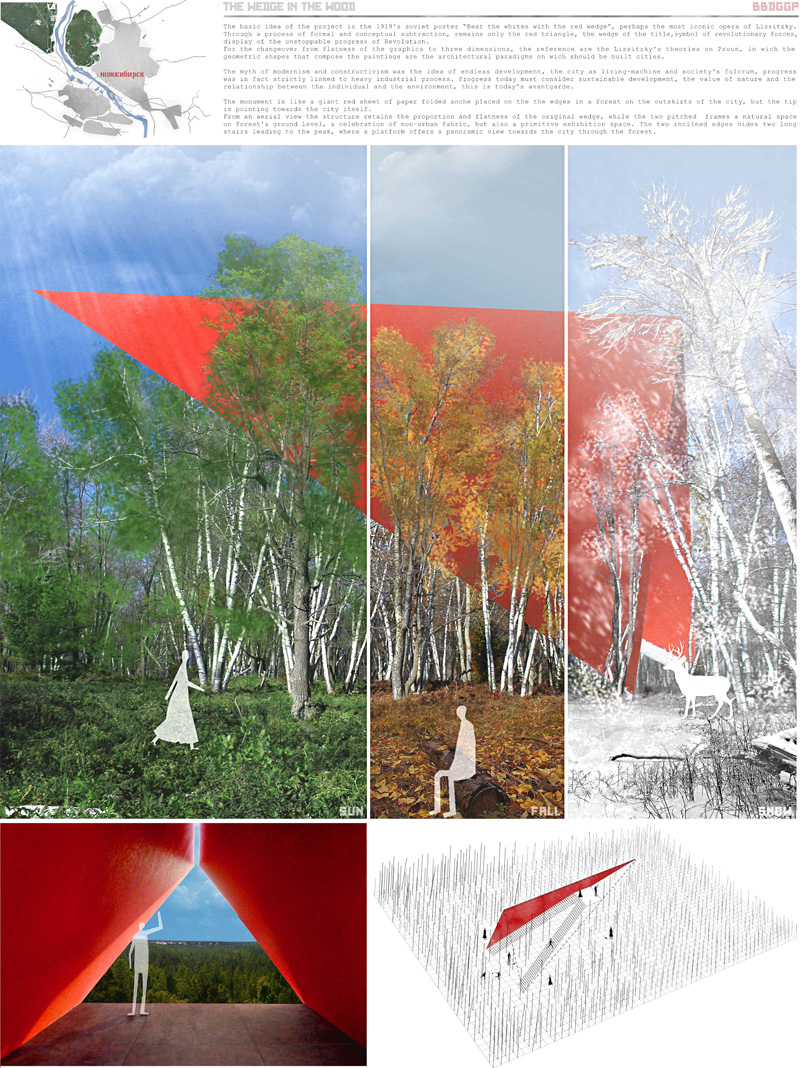Клин в лесу / The wedge in the wood
Клин в лесу
Основная идея проекта - советский плакат 1919 года «Клином красным бей белых», который является, пожалуй, наиболее известным произведением Лисицкого. При формальном и концептуальном вычитании остаётся только красный клин, клин из заголовка, символ революционных сил, демонстрация неудержимого пути Революции.
Для перехода от плоской графики к трём измерениям отправной точкой стала теория Лисицкого о Проуне, когда геометрические фигуры картины становятся архитектурными парадигмами, используя которые можно строить города.
Мифом модернизма и конструктивизма была идея бесконечного развития, города как живой машины и точки опоры общества, а прогресс был прямо связан с развитием тяжёлой промышленности. Прогресс сегодня должен учитывать устойчивое развитие, ценность природы и отношений между человеком и средой - вот сегодняшний авангард.
Памятник подобен гигантскому сложенному листу красной бумаги, положенному на бок в лесу за пределами города, остриё указывает на город. При взгляде с воздуха структура сохраняет пропорции и плоскость первоначального клина, два расходящихся луча образуют естественное пространство на уровне земли - простейший выставочный зал. В лучах скрыты две длинные лестницы наверх к вершине, где есть смотровая площадка с видом на город из леса.
The wedge in the wood
The basic idea of the project is the 1919's soviet poster “Beat the whites with the red wedge”, perhaps the most iconic opera of Lissitzky. Through a process of formal and conceptual subtraction, remains only the red triangle, the wedge of the title, symbol of revolutionary forces, display of the unstoppable progress of Revolution.
For the changeover from flatness of graphic to three dimensions, the reference are the Lissitzky's theories on Proun, in wich the geometric shapes that compose the paintings are the architectural paradigms on wich should be built cities.
The myth of modernism and constructivism was the idea of endless development, the city as living-machine and society's fulcrum, progress was in fact strictly linked to heavy industrial processes.
Progress today must consider sustainable development, the value of nature and the relationship between the individual and environment, this is today's avantgarde.
The monument is like a giant red sheet of paper folded anche placed on the the edges in a forest on the outskirts of the city, but the tip is pointing towards the city itself.
From an aerial view the structure retains the proportion and flatness of the original wedge, while the two pitched frames a natural space on forest's ground level, a celebration of non-urban fabric, but also a primitive exhibition space. The two inclined edges hides two long stairs leading to the peak, where a platform offers a panoramic view towards the city through the forest.





Добавить комментарий